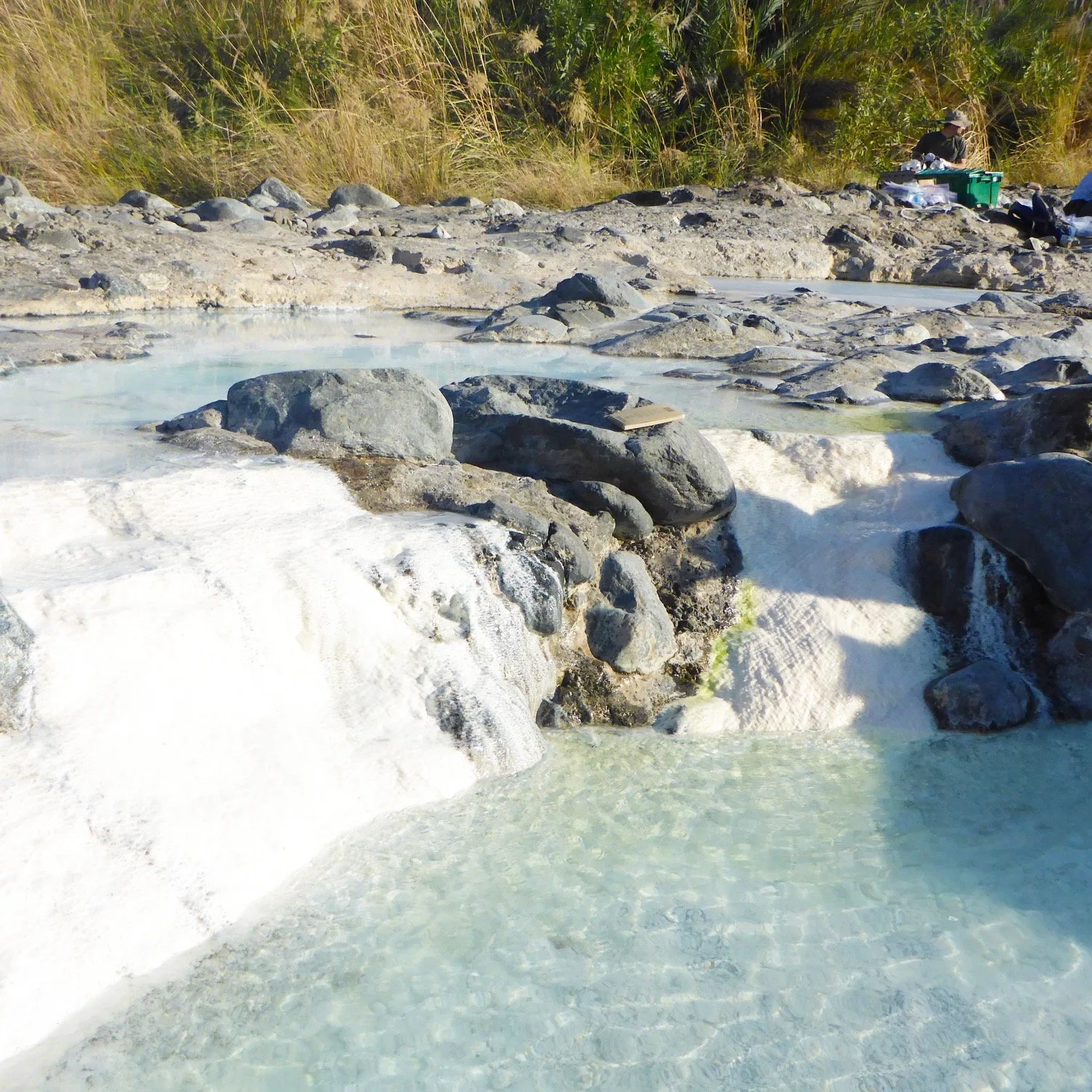How Hydrogen-Fueled Ecosystems in Oman’s Subsurface Could Rewrite the Rules of Biology
In the depths of Oman, a hidden world thrives in darkness – fueled not by sunlight, but by hydrogen-rich fluids seeping through ancient rocks.
By Gabriella Rizzo
This image captures a travertine waterfall formed of serpentinized fluids. The striking white color results from atmospheric carbon dioxide reacting with the fluid, leading to the precipitation of carbonate minerals. Consequently, the fluids contain extremely low levels of dissolved inorganic carbon. In the background, co-author Kirtland Robinson is preparing to collect fluid samples to analyze for organic acids like formate and acetate, which could serve as alternative substrates for methanogenesis in serpentinized fluids. Credit: Jame Leong
Scientists have long believed that life depends on sunlight or organic material for energy. But in the Oman subsurface, microorganisms are challenging that assumption. These ecosystems rely on hydrogen generated by serpentinization – a geological process where water reacts with rock, generating hydrogen-rich fluids (1). This reaction creates a chemically rich environment capable of supporting microbial life, such as methanogens – microorganisms that produce methane.
A new study suggests that where hydrogen-based metabolisms would be expected to dominate, energetic and genomic analyses indicate otherwise. The findings demonstrate that carbon limitation plays a crucial role in shaping microbial metabolism, altering the expected energetics in these systems.
The study, led by Alta Howells, a staff scientist at Blue Marble Space Institute of Science and affiliate at NASA Ames Research Center, reveals that methanogens in this system have an unexpected energetic drive for formatotrophic methanogenesis, reshaping our current understanding of the system’s metabolic dynamics. Published in Frontiers in Microbiology, the study combined geochemical analysis of surface-expressed fluids with genomic sequencing to uncover the metabolic capabilities of the resident methanogens (2).
Howells described how this work began: “An opportunity came about to do research in Oman. I was notified 10 days in advance that I’d be going for 2 weeks…those 2 weeks fired decades of research,” Howells said.
Previous studies have shown that hydrogenotrophic methanogenesis – converting hydrogen and carbon dioxide into methane – occurs in these fluids (3). However, Howells and her team found that in the Samail Ophiolite, formatotrophic methanogenesis (using formate as a carbon source) yielded more energy than hydrogenotrophic or acetoclastic methanogenesis (using acetate). Given the high pH (above 11) of the fluids, which drastically lowers dissolved inorganic carbon availability, the ability to metabolize formate and acetate may be a critical survival strategy for the resident methanogens.
“My motivation [for this work] was that there must be some reason that methanogens require more energy. They have tons of hydrogen in these systems due to the process of serpentinization, but they’re very carbon-limited,” she explained. “That’s pushed me to dig deeper. What’s the energetic cost of living in these systems?”
These energetic calculations are further supported by genomics, which revealed potential for both hydrogenotrophic and formatotrophic methanogenesis by a methanogen of the genus Methanobacterium. Additionally, the study uncovered the first detection of an acetoclastic methanogen from the family Methanosarcinaceae in continental serpentinized fluids – a discovery previously confined to the Lost City hydrothermal vent field (4). Surprisingly, the genomes of potential acetoclastic methanogens from Oman and Lost City differ markedly from those typically found in carbon-rich environments, suggesting they represent a new, distinct group. This challenges the expectation that hydrogenotrophic methanogens would dominate in such conditions.
Jim Holden, a microbiologist at the University of Massachusetts Amherst who studies microorganisms in seafloor hydrothermal vents, described the findings as a major step forward in understanding methanogen metabolism: “…the idea that methanogens in serpentinized fluids (high pH, low DIC) could grow on formate and acetate is very intriguing and opens new lines of investigation,” Holden said. Holden was not involved in the study.
Howells believes these findings could shape future life-detection strategies. “I think it could have consequences for how we design instrumentation for life detection,” she said. “I also think about the MASPEX instrument on the Europa Clipper mission…my sense is that perhaps if we open our minds to considering formatotrophic and acetoclastic methanogenesis, it might shape how we interpret data that Clipper collects.”
Holden added, “Life is constantly pushing the envelope of the perceived limits that we place on it. It still possesses surprises for us if we are willing to search for them.”
Understanding how these deep ecosystems function could unlock new insights into early Earth’s biology and inform the search for extraterrestrial life. Oman’s hydrogen-fueled microbes are more than a scientific curiosity – they may hold the key to understanding life’s resilience in the most extreme environments.
References:
1. Jöns, N., Bach, W. (2014). Serpentinization. In: Harff, J., Meschede, M., Petersen, S., Thiede, J. (eds) Encyclopedia of Marine Geosciences. Springer, Dordrecht. https://doi.org/10.1007/978-94-007-6644-0_119-1
2. Howells, Alta E. G., Lilja M. Quinn, Miguel G. Silva, Kylie Akiyama, Lucas M. Fifer, Grayson Boyer, Srishti Kashyap, et al. “Energetic and Genomic Potential for Hydrogenotrophic, Formatotrophic, and Acetoclastic Methanogenesis in Surface-Expressed Serpentinized Fluids of the Samail Ophiolite.” Frontiers in Microbiology 15 (2025). https://doi.org/10.3389/fmicb.2024.1523912.
3. Canovas, P. A. III, Hoehler, T., and Shock, E. L. (2017). Geochemical bioenergetics during low-temperature serpentinization: an example from the Samail ophiolite, Sultanate of Oman. J. Geophys. Res. Biogeo. 122, 1821–1847. https://doi.org/10.1002/2017JG003825
4. McGonigle JM, Lang SQ, Brazelton WJ. 2020. Genomic Evidence for Formate Metabolism by Chloroflexi as the Key to Unlocking Deep Carbon in Lost City Microbial Ecosystems. Appl Environ Microbiol 86:e02583-19. https://doi.org/10.1128/AEM.02583-19

